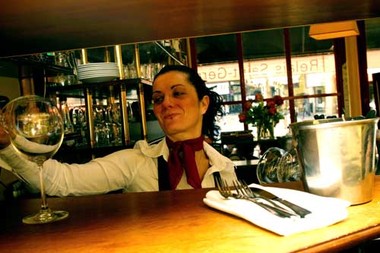Beyond Spain’s Master
May 31, 2006 - Newsday

Paris - For the last few years, it seems like every other food story coming out of Europe has focused on superstar Spanish chef Ferran Adria and his restaurant, El Bulli. Creating cuisine that sometimes seems flown in from another plane - stuff like “spherical melon caviar” and “malt ravioli with butter sea urchin and lime,”- it’s once-in-a-lifetime stuff and far from everyday food.
Despite the propensity of the press to cover Adria ‘s every move, there’s other food and wine news on The Continent.
France
While they more than amply cover their Adria -esque bases with the pairing of molecular gastronomist Hervé This and three-star chef Pierre Gagnaire, the French are doing their own thing. Here, the lion’s share of excitement is focused on a movement toward gastronomic democracy: the gastro bistro.
After toiling for years in some of the fanciest French restaurants, the movement’s kingpin, Yves Camdeborde, got gastro bistros going in the 1990s when he traded pomp and circumstance for casual bistro ambience and opened La Régalade in a far-flung corner of Paris. Slowly, and often with Camdeborde’s moral and financial support, other gastro bistros such as Le Beurre Noisette, Chez Michel and L’Osa Moëlle began springing up in remote corners of the city.
A recent dish at Camdeborde’s new restaurant, Le Comptoir featured eggplant rolls and lamb confît, with a sauce made from lamb’s foot and pesto. At L’Osa Moëlle, chef Thierry Faucher created a dessert of basil ice cream sitting on crushed ice flavored with rosé champagne, circled by raspberries and a mint sauce.
Several-course tasting menus at these restaurants tend to be astonishingly inexpensive at about 30 to 40 euros (before wine).
Italy
Adria -style cuisine is a tough sell here. At Modena’s Osteria Francescana, chef Massimo Bottura felt the pinch firsthand.
Speak with him for a few minutes about a dish he calls “Morning Fog” and you start wondering if you’re talking to a chef or an abstract artist.
“I started thinking about fog and a dish I grew up with that used veal, prosciutto, Parmesan and sage - so I get the best veal ever and serve it raw at the bottom of the plate, then I pour a thick stock over the top ; I’m making earth. Then I grate a crust of truffle over the topa ” and before he remembers to presumably describe the trees or the fog, he starts talking excitedly about something else.
Chef Mauro Uliassi offers more concrete examples what he’s doing. At his restaurant, Uliassi, in the nearby coastal town of Senigallia, he takes cues from modern masters like Adria and Paul Bocuse of France, then folds Italy into the mix.
He demonstrates this with “cuttlefisha la carbonara” - a dish that brings to mind unflattering adjectives like “gummy” and “gross” but in Mauro’s hands, it’s another kettle of cephalopods.
Taking advantage of the fact that Cryovack (or sous vide) cooking hasn’t been outlawed in Italy (like in NYC), he starts by cooking vac-packed cuttlefish for three hours in a pot of water maintained at precisely 131 degrees Farenheit. Shaved into long ribbons, the cuttlefish becomes the “pasta,” right down to the al dente texture. He tops it with oven-crisped pancetta and grated Cryovacked egg yolk.
Spain
While Adria dazzles at El Bulli, the rest of the country revels in everything from dishes influenced by his style of cooking to tapas bars that have seen few changes in decades.
A nation of foodies with little pretense, their curiosity is now branching into wine.
Meritxell Falgueras was one of Spain’s youngest-ever sommeliers and was even elected “Miss Cava” in 1999, an honor bestowed on her by the makers of the country’s sparkling wine. Together with her father and brother, she runs the Celler de Gelida, one of Barcelona’s top wine shops.
Between TV appearances, wine conferences, literature critiques, English classes and the shop, she is a strong symbol of an industry moving from an historical position of creating plonk used to wash down lunch to one that is diversifying and becoming world-class.
“Now,” she says, “wine is becoming a bit like art and younger people are learning a little bit about it, then wanting to know more,” something that has been pushing Spanish winemakers to greater heights - a difference we are tasting on these shores.
Falgueras says that people are slowly branching out from Spanish classics like Rioja and Priorat, and experimenting with wines like Toro, Somontano and Rueda.
“You used to have to drink French wine to drink great wine,” she says. “Now, Spain is making some of the best wines of the world.”